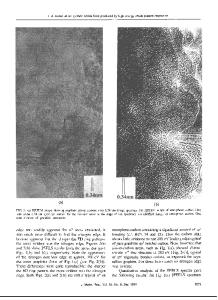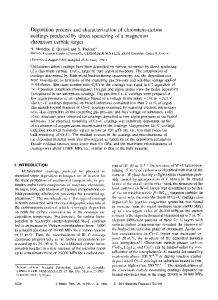Electrical Characterization of Nanostructured Carbon Films Produced by Supersonic Cluster Beam Deposition
- PDF / 131,613 Bytes
- 6 Pages / 612 x 792 pts (letter) Page_size
- 96 Downloads / 328 Views
Electrical characterization of nanostructured carbon films produced by Supersonic Cluster Beam Deposition Paolo Piseri1, Emanuele Barborini1, Mara Bruzzi2, Stefania Miglio2, Gero Bongiorno1 and Paolo Milani1 1 INFM -Università degli Studi di Milano, Dipartimento di Fisica, Via Celoria 16, 20133 Milano, Italy. 2 INFM -Università di Firenze, Dipartimento di Energetica, Via S. Marta 3, 50139 Firenze, Italy. ABSTRACT Electrical conduction in nanostructured carbon (ns-C) films produced by deposition of a supersonic beam of neutral carbon clusters has been studied. The d.c. conduction properties of these films have been measured in-situ during the deposition process and ex-situ as a function of the temperature in vacuum and in ambient of different gases (H2, N2, CH4, He). The ns-C films exhibit an ohmic behavior with a room temperature resistivity in the range 10MΩcm-1GΩcm depending on the growth and storage conditions. Conductivity vs. temperature measured in vacuum in the range 300-400K is characterized by activation energies in the range 0.3-0.7eV, the current response does not differ significantly in gas atmosphere. INTRODUCTION The understanding of electronic transport phenomena in disordered media attracts the interest of a large scientific community, mainly focussed on the role of nanoscale disorder on the localization of electronic states [1,2]. Amorphous carbon in its many different variant forms is an interesting candidate for these studies and stimulated many works in the recent past [2,3]. Conductivity, in these materials, has been ascribed to the segregation of sp2 phases with conjugation of π bonds that in a mixed sp2/sp3 system can cause the appearance of complex transport phenomena [4,5]. Carbon materials with resistivities rather uniformly distributed in the whole range from graphite to diamond have been observed [6]. The development of an industrially scalable carbon film deposition technique providing a continuous tuning of the conductivity, over even a part of this range, would be a valuable tool for the production of electronic devices. The study of electrical conduction in ns-C based materials is thus of great interest both for developing new applications and for fundamental studies. Supersonic Cluster Beam Deposition (SCBD) can be used to grow nanostructured thin films where the identity of clusters, after deposition, is conserved to a large extent [7]. With this technique, it is possible to tailor structure and properties of the ns-C films simply by changing dimension and/or structure of the clusters. The electrical conductivity of ns-C films is quite sensitive to the properties of the deposited clusters: the resistivity may change by up to three orders of magnitude by changing the cluster dimensions, and even more by introducing metallic impurities in the beam. This feature suggests the possibility of producing materials with tailored electrical properties.
W9.38.1
Moreover, due to the high porosity, the conductivity of ns-C films should be strongly sensitive to the gaseus environment: this pro
Data Loading...










